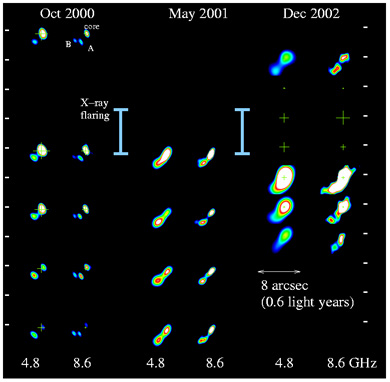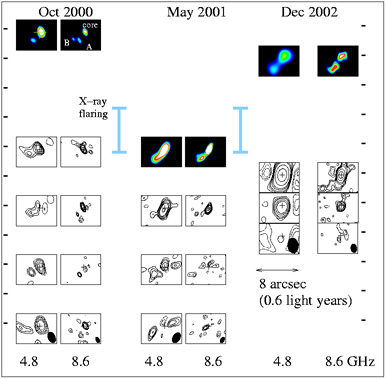Neutron Star Imitates Black Hole
14th January 2004

An ultrarelativistic jet: a series of radio observations at 4.8 and 8.6 GHz, in (from left to right) October 2000, May 2001, December 2002, of Circinus X-1, obtained with the Australia Telescope Compact Array. Each tick indicates one day. The blue bars indicate X-ray outbursts as observed by NASA's Rossi X-ray Timing Explorer. The crosses indicate the location of the neutron star; the size of the cross indicates the strength of the radio emission. Following an X-ray outburst the extended radio structure lights up within a couple of days, indicating interaction with a jet moving at more than 99.8% of the speed of light.
An international team of Dutch, UK and Australian scientists using the Australia Telescope - a radio-telescope array in New South Wales, Australia - have seen a neutron star spitting out a jet of matter at more than 99.8% of the speed of light. This is the first time such an ultra-relativistic jet has been seen from anything other than a super massive black hole at the heart of a distant galaxy.
The discovery, reported in this week's issue of the journal Nature, challenges the idea that only black holes can create the conditions needed to accelerate jets of particles to extreme speeds. "Making jets is a fundamental cosmic process, but one that is still not well understood even after decades of work," says team leader Dr Rob Fender of the University of Amsterdam. "What we've seen should help us understand how much larger objects, such as supermassive black holes, can produce jets that we can see half-way across the Universe."
The scientists have studied a binary star system called Circinus X-1 over a three-year period. It is a bright and variable source of cosmic X-rays which lies in our Milky Way galaxy at a distance of about 20,000 light years and consists of two stars: a 'regular' star, probably about 3 to 5 times the mass of our Sun, and a small compact companion. "We know that the companion is a neutron star from the kind of X-ray bursts it's been seen to give off," says team member Dr Helen Johnston of the University of Sydney.

The same as above, but in the form of "difference maps". The top panel
indicates the image which has been subtracted from the subsequent images,
and the difference between them is presented as the contour images. Solid
lines indicate a positive difference (brightening with respect to the top
image), dashed lines a negative difference (fading). It is clear that with
respect to the first image the extended jet structure lights up following
the X-ray outburst.
A neutron star is a compressed, very dense ball of matter formed when a giant star explodes at the end of its life - a mass, somewhat more than our Sun in a volume the size of Manchester! In the hierarchy of extreme objects in the Universe, it is just one step away from a black hole. The two stars in Circinus X-1 interact, with the neutron star's gravity pulling matter off the larger star onto the neutron star's surface. This 'accretion' process generates the X-ray output. The strength of the X-ray emission varies over a period of 17 days, indicating that the two stars of Circinus X-1 are in a very elliptical orbit with a 17 day period.
Since the 1970's astronomers have known that Circinus X-1 produces radio waves as well as X-rays. A large 'nebula' of radio emission lies around the X-ray source. Within the nebula lies the new-found jet of radio-emitting material thought to be associated with an accretion disk of material falling in towards the neutron star. In Circinus X-1 its likely that the accretion disk varies with the 17-day cycle, being at its most intense when the stars are almost touching at the closest point in the orbit. It is then that the jets of matter appear to be ejected from the system.
Jets with speeds of ~ 99% (see note *) of the speed of light have been observed being emitted from the the regions around black holes in our own galaxy and have occasionally been seen emanating from neutron stars, but never before has an ultra-relativistic jet been seen that did not originate from a black hole region. The team has shown that the jets in Circinus X-1 are travelling at 99.8% of the speed of light. This is the fastest outflow seen from any object in our Galaxy, and matches the fastest jets powered by supermassive black holes at the heart of distant galaxies. Whatever process accelerates the jets to near the speed of light, it cannot therefore rely on the special properties of a black hole. "The key process must be one common to both black holes and neutron stars" said Kinwah Wu, formerly of the University of Sydney, now at University College London in the UK.
(* Because the speed of light is an absolute limit, the difference between 99% and 99.8% of the speed of light is very large, and a great deal of energy is required to accelerate matter from one to the other - more than is required to accelerate matter from 0-99% of the speed of light in the first place! Matter moving at 99.8% of the speed of light has its time `stretched' and its effective mass increased, by a factor of more than 15.)
Team Members
Rob Fender (University of Amsterdam, NL)
Kinwah Wu (University College London, UK)
Helen Johnston (University of Sydney,Australia)
Tasso Tzioumis (Australia Telescope National Facility,Australia)
Peter Jonker (University of Cambridge, UK)
Ralph Spencer (Jodrell Bank / University of Manchester, UK)
Michiel van der Klis (University of Amsterdam, NL)
Publication
Rob Fender, Kinwah Wu, Helen Johnston, Tasso Tzioumis, Peter
Jonker, Ralph Spencer & Michiel van der Klis.
"An ultra-relativistic outflow from a neutron star accreting gas from a companion".
Nature 427,222-224 (2004).
Acknowledgement
The Australia Telescope is funded by the Commonwealth of Australia for operation as a national facility by CSIRO.
Contacts
Dr Rob Fender, University of Amsterdam
Tel: +31 20 5257478
Email: rpf@science.uva.nl
Dr Kinwa Wu, University College London.
Tel: +44 1483 204127
Email: kw@mssl.ucl.ac.uk


